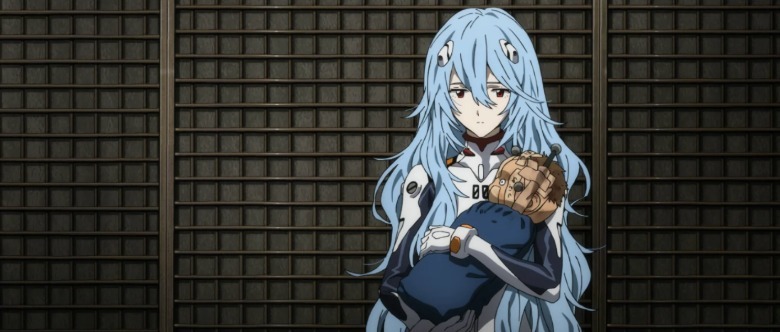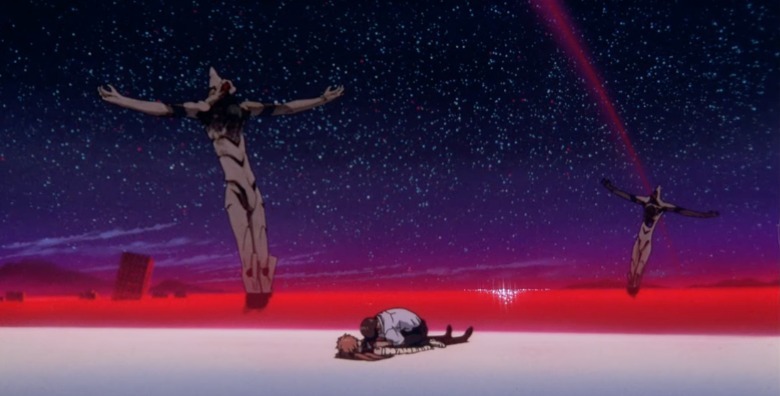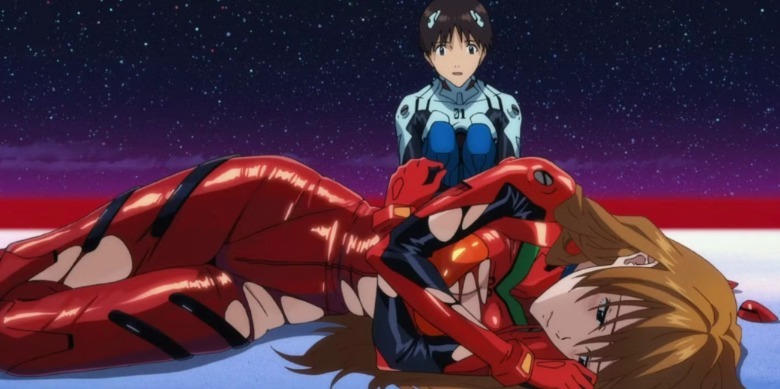The primary half of “Thrice Upon A Time” is about in a peaceable village, the place Shinji, Asuka, and Rei take a break from the motion. Their previous mates Toji, Kensuke, and Hikari have all grown up, turning into adults and constructing peaceable, regular, and home lives that the Pilots have been cursed to not. Shinji breaks the curse and offers his mates the prospect to stay these lives.
In Shinji and Rei’s final scene collectively, she is holding a doll representing an toddler. Motherhood has been a motif with Rei’s character going again to the unique “Evangelion,” and clearly a dream she may by no means understand, particularly with the newly-introduced curse.
Shinji and Asuka’s goodbye takes place on a surreal shoreline with blood pink water, a sight acquainted to “Evangelion” followers.
“Finish of Evangelion” concludes with Shinji and Asuka mendacity collectively on that very same seashore; they’re apparently the one two who’d chosen the painful uncertainty of actuality over the bliss of non-existence. Shinji strangled Asuka, whereas she caressed his cheek. Shinji stopped and started to cry, as Asuka seemed on in revulsion and whispered, “How disgusting.” That scene is a microcosm of the connection the 2 share and the world they stay in, the place folks can hold hurting others again and again even when beneath all of it they care about one another (which is among the methods “Evangelion” resembles “Everlasting Sunshine of the Spotless Thoughts”). Shinji and Asuka have at all times been on that seashore — however no extra. They admit they appreciated one another as soon as, however have grown aside and it is time to transfer on. To point out this time is completely different? Asuka is lastly an grownup; her previous Eva plugsuit is half-torn and her hair braids are discarded on the bottom, as a result of she now not has any use for them.
Shinji’s last act is giving the world a contemporary begin. He and everybody else can solely be completely satisfied in a world with no Evangelions (gee, surprise what Anno is saying there), so that’s the “Neon Genesis” he creates. Within the final scene, an grownup Shinji meets Mari at a practice station and so they run off into a brand new world, the actual world, and one brimming with chance. The Curse of Eva and the cycle of stagnation it represented is damaged.
In “The Finish of Evangelion,” Misato tells a near-catatonic Shinji that, to stay, he cannot be afraid to make errors. She’s saved making the identical ones time and again, studying a little bit bit extra every time, and that’s inevitable whenever you select to simply accept the dangers that life brings. On the finish of the movie, Shinji has accepted that too; his happiness shouldn’t be assured, however higher that he offers himself the prospect to search out it.
The message of “Evangelion” by no means modified (settle for your self, since you’re all you’ve got bought endlessly, and go and discover your happiness), it merely advanced. Anno ended “Evangelion” the primary time by leaving his characters in uncertainty, and he returned to it to finish their journey. By letting his characters develop and transfer on, he hopes his followers will too. If Shinji and Asuka realized there’s far more to this life than Evangelions, why cannot we?


